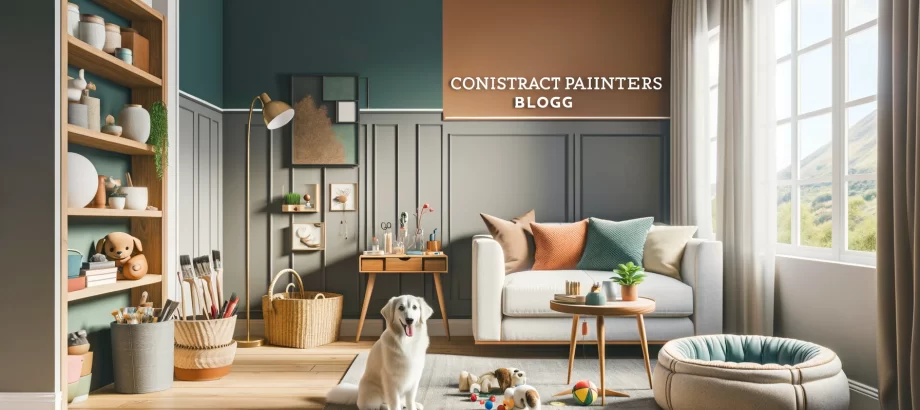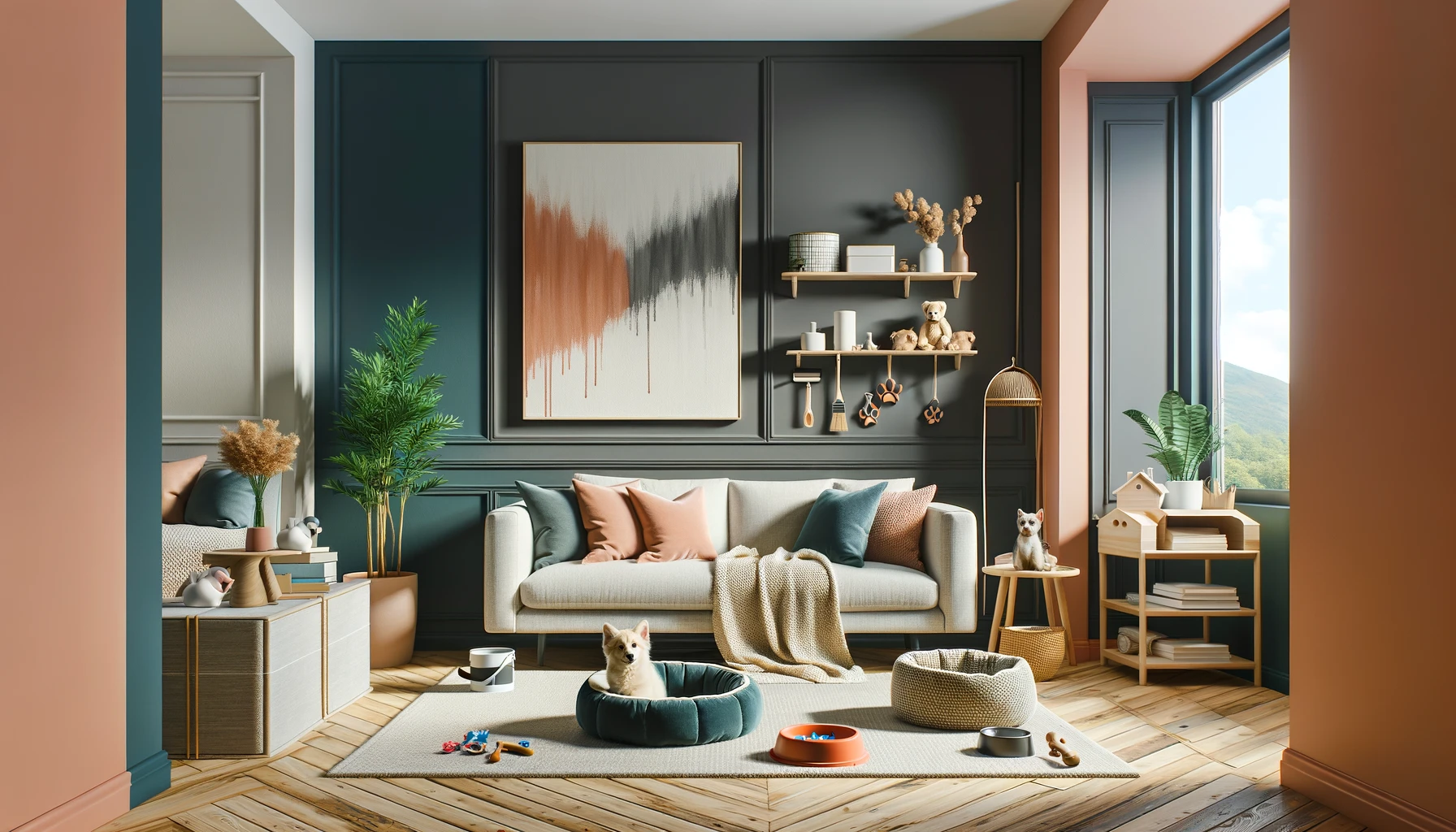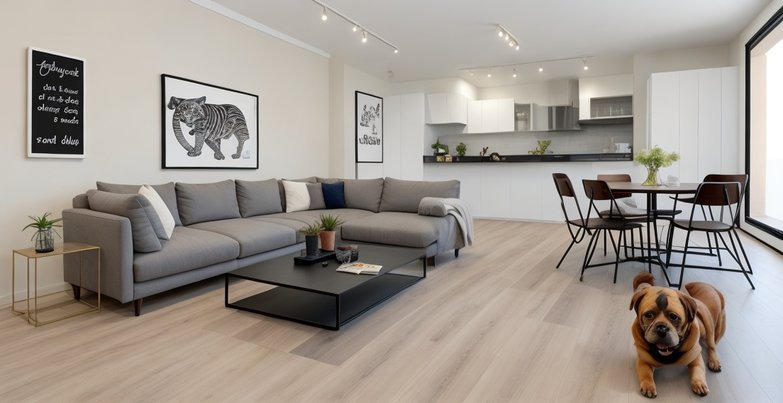How to Design a Pet-Friendly Home

Are you ready to discover the secrets of designing a pet-friendly haven?
In this guide, we’ll unveil some killer strategies and practical tips to ensure you create the ultimate living space for your adorable furry companions.
We’ll dive into the world of pet-friendly materials, show you how to incorporate designated zones and furniture, and strike that perfect balance between style and functionality.
Whether you’re a pet owner looking to amp up your home or a design enthusiast eager to cater to pet lovers, this article is tailor-made just for you.
So buckle up and let’s get started on this epic journey!
Key Takeaways
- Choose pet-friendly materials and surfaces, such as low VOC paint and durable window treatments, furniture, and flooring options.
- Create designated pet zones within your home to keep it organized and prevent furniture damage.
- Opt for flooring options that are resistant to scratches, stains, and accidents caused by pets, and are easy to clean.
- Select low-maintenance furniture choices with durable fabrics and materials, such as leather or microfiber, that are resistant to scratches and easy to clean.
Choosing Pet-Friendly Materials
Selecting appropriate materials is crucial when designing a pet-friendly home. One of the key considerations is choosing pet-friendly paint options. Traditional paints often contain harmful chemicals that can be toxic to pets if ingested or inhaled. To ensure the safety of your furry companions, opt for pet-friendly paint options that are low in volatile organic compounds (VOCs) and free from toxic ingredients. These paints are specially formulated to be non-toxic and safe for pets, providing a healthier environment for everyone in the household.
Another important aspect to consider when designing a pet-friendly home is the choice of window treatments. Pets, especially cats, love to climb and play near windows. It is essential to select window treatments that are durable and resistant to pet damage. Avoid materials like delicate fabrics or blinds with cords that can be hazardous to pets. Instead, opt for pet-friendly window treatments such as sturdy fabrics, cordless blinds, or window film. These options not only withstand pet activity but also provide a safe and enjoyable environment for your pets.

Creating Designated Pet Zones
To ensure a well-organized and harmonious living space for both you and your pets, it is important to create designated pet zones within your home.
These areas will provide your furry friends with a sense of belonging while maintaining your freedom and independence.
When creating pet-friendly play areas, consider integrating pet-friendly technology to enhance their experience.
For instance, you can install automatic pet doors that allow them to access their designated zones easily.
Additionally, consider incorporating interactive toys and scratching posts to keep them entertained and prevent them from damaging furniture.
Incorporating Easy-to-Clean Surfaces
When designing a pet-friendly home, it is essential to incorporate easy-to-clean surfaces. This includes choosing pet-friendly flooring options that are resistant to scratches, stains, and accidents.
Additionally, opting for low-maintenance furniture choices, such as durable fabrics and materials that can be easily wiped clean, will help ensure a hygienic and pet-friendly living space.
Pet-Friendly Flooring Options
Pet-friendly homes require flooring options that incorporate easy-to-clean surfaces. When choosing pet-friendly flooring, it is essential to consider both installation and maintenance aspects.
Here are some key points to keep in mind:
- Durability: Opt for durable flooring materials that can withstand scratches, stains, and accidents caused by pets.
- Waterproof or stain-resistant: Choose flooring options that are resistant to water damage or stains, making it easier to clean up any messes.
- Easy to clean: Look for flooring that can be easily cleaned with regular sweeping, mopping, or vacuuming.
To ensure proper pet-friendly flooring maintenance, it is crucial to follow manufacturer’s guidelines and recommendations. Additionally, professional pet-friendly flooring installation can help ensure longevity and functionality.
Low-Maintenance Furniture Choices
Incorporating low-maintenance furniture choices with easy-to-clean surfaces is essential for designing a pet-friendly home. When it comes to selecting furniture, it’s important to consider durable fabric choices and scratch-resistant coatings.
Opting for fabrics such as microfiber or leather can be a wise choice as they are known for their durability and resistance to stains and pet hair. These materials can be easily wiped clean or vacuumed, making them ideal for households with pets.
Additionally, furniture with scratch-resistant coatings can withstand the occasional clawing or jumping from our furry friends. By selecting furniture with these features, pet owners can enjoy the freedom of a stylish and comfortable home while ensuring that their furniture remains in good condition.

Ensuring Ample Storage for Pet Supplies
To ensure sufficient storage for pet supplies, it is essential to incorporate a range of designated areas specifically designed for organizing and storing all necessary items. When designing a pet-friendly home, maximizing vertical space is key to creating ample storage options.
Consider installing tall cabinets or shelving units that can accommodate pet food, toys, and grooming supplies. Additionally, integrating pet-friendly appliances, such as built-in feeding stations or storage compartments for leashes and collars, can help keep everything organized and easily accessible.
Another great storage solution is to designate a specific area for pet supplies, such as a mudroom or laundry room, where you can install hooks for leashes, shelves for treats, and bins for toys.
By incorporating these storage ideas, you can ensure a clutter-free and organized space for all your pet’s needs.
Now, let’s move on to the next section on implementing pet-friendly furniture.
Implementing Pet-Friendly Furniture
When designing a pet-friendly home, it is important to carefully consider the furniture you choose. Opt for materials that are durable and easy to clean, such as stain-resistant fabrics or leather.
Additionally, incorporating hidden pet features like built-in pet beds or scratching posts can help keep your furniture safe and minimize damage.
Finding a balance between style and functionality is key to creating a home that is both pet-friendly and aesthetically pleasing.
Choosing Pet-Friendly Materials
Implementing pet-friendly furniture is an essential aspect of designing a home that accommodates the needs of both pets and their owners. When choosing pet-friendly materials for your furniture, it is important to consider durability and ease of cleaning. Opt for stain-resistant fabrics that can withstand the occasional accident or muddy paws. Leather or microfiber are great options as they are both durable and easy to clean.
Additionally, when designing a pet-friendly garden, choose plants that are non-toxic to pets, such as petunias, marigolds, and sunflowers. Avoid plants like lilies, daffodils, and tulips, which can be harmful if ingested.
Lastly, consider using pet-friendly paint that is non-toxic and easy to wipe clean, ensuring the safety of your furry friends. By choosing pet-friendly materials, you can create a home that is both stylish and functional for your beloved pets.
Incorporating Hidden Pet Features
One way to design a pet-friendly home is by incorporating hidden pet features, such as pet-friendly furniture. These specially designed pieces of furniture not only provide comfort and style for your home but also cater to the needs of your furry friends. With hidden pet features, you can seamlessly integrate pet-friendly elements into your home decor while maintaining a sleek and modern look.
One of the key features to consider is outdoor pet accessibility. This can be achieved by incorporating hidden pet doors or ramps that allow your pets to easily access the outdoors. These hidden features ensure that your pets can move freely between indoor and outdoor spaces without any inconvenience.
To help you visualize the possibilities, here is a table showcasing some examples of hidden pet features and their benefits:
| Hidden Pet Feature | Benefits |
|---|---|
| Built-in pet bed | Saves space and provides a cozy spot for your pet to relax |
| Cat shelves | Creates vertical space for cats to climb and explore |
| Hidden litter box | Conceals the litter box, keeping it out of sight and reducing odor |
Balancing Style and Functionality
To achieve a harmonious blend of aesthetics and practicality in your pet-friendly home, it is essential to carefully select and incorporate furniture that caters to both your style preferences and the needs of your furry companions.
Here are some key points to consider when implementing pet-friendly furniture:
- Maximize space: Opt for furniture with built-in storage compartments or hidden pet-friendly features, such as hidden litter boxes or pet beds that can be tucked away when not in use.
- Incorporate natural elements: Choose furniture made from pet-friendly materials like leather or microfiber, which are easy to clean and resistant to scratches. Additionally, consider adding indoor plants or natural textures to create a calming and inviting atmosphere for both you and your pets.
- Choose durable and easy-to-clean fabrics: Look for furniture with removable, machine-washable covers or stain-resistant fabrics to make cleaning up after your pets a breeze.
Maximizing Safety Measures for Your Pet
Ensuring the safety of your furry companion is a top priority when designing a pet-friendly home. By implementing pet proofing techniques and focusing on outdoor pet safety, you can create a secure environment for your beloved pet.
Start by inspecting your home for potential hazards such as loose wires, toxic plants, or small objects that can be swallowed. Use pet gates or barriers to restrict access to certain areas and secure cabinets and drawers to prevent your pet from getting into harmful substances.
When it comes to outdoor pet safety, make sure your yard is securely fenced and free from any dangerous plants or chemicals. Consider installing a pet-friendly outdoor space with artificial grass or soft surfaces to prevent injuries. Regularly inspect fences for any gaps or damage that could allow your pet to escape.
Enhancing Indoor and Outdoor Pet Accessibility
To further facilitate your pet’s movement and exploration, it is important to enhance both indoor and outdoor pet accessibility in your home design. Here are some ways to achieve this:
- Create outdoor pet enclosures: Design a safe and secure area in your yard where your pet can play and roam freely. Install fences or enclosures that are tall enough to prevent escape and ensure that the space is free from potential hazards.
- Incorporate pet-friendly landscaping: Consider using pet-friendly materials in your outdoor space, such as artificial turf or gravel, which are easy to clean and maintain. Plant pet-friendly plants and avoid toxic ones that could harm your furry friend. Provide shady areas and water sources to keep your pet comfortable.
- Install pet doors: Install pet doors in strategic locations, allowing your pet to access both indoor and outdoor areas easily. This provides them with the freedom to explore and enjoy the outdoors while still having the option to come inside.
Frequently Asked Questions
How Do I Introduce My New Pet to My Pet-Friendly Home?
Introducing a new pet to a pet-friendly home requires careful planning and consideration. Begin by creating a separate space for the new pet to adjust and gradually introduce them to the existing pets, providing supervision and positive reinforcement throughout the process.
What Are Some Tips for Keeping My Pet Calm During the Design and Construction Process?
Tips for managing pet anxiety during the design and construction process include creating a safe space for your pet, using calming scents or music, and gradually introducing them to the changes. Incorporating pet-friendly materials into the design can also help promote a peaceful environment for your furry friend.
Are There Any Specific Design Considerations for Homes With Multiple Pets?
When considering homes with multiple pets, it is important to address their specific needs to create a pet-friendly environment. This involves incorporating features such as designated pet areas, durable flooring, and ample storage for pet supplies.
How Can I Create a Pet-Friendly Outdoor Space Without Sacrificing Aesthetics?
When creating a pet-friendly outdoor space without sacrificing aesthetics, it is essential to consider the selection of outdoor furniture and landscaping ideas that are both functional and visually appealing.
Are There Any Specific Design Considerations for Homes With Small or Large Pets?
Design considerations for homes with exotic pets involve creating a safe and stylish pet play area. This includes providing adequate space, incorporating appropriate materials, and ensuring the area is free from potential hazards.
